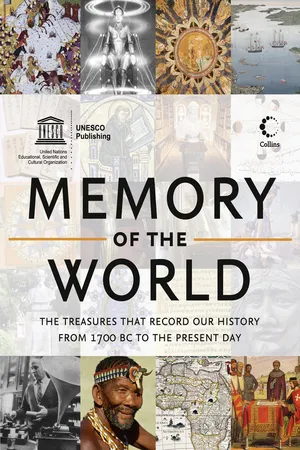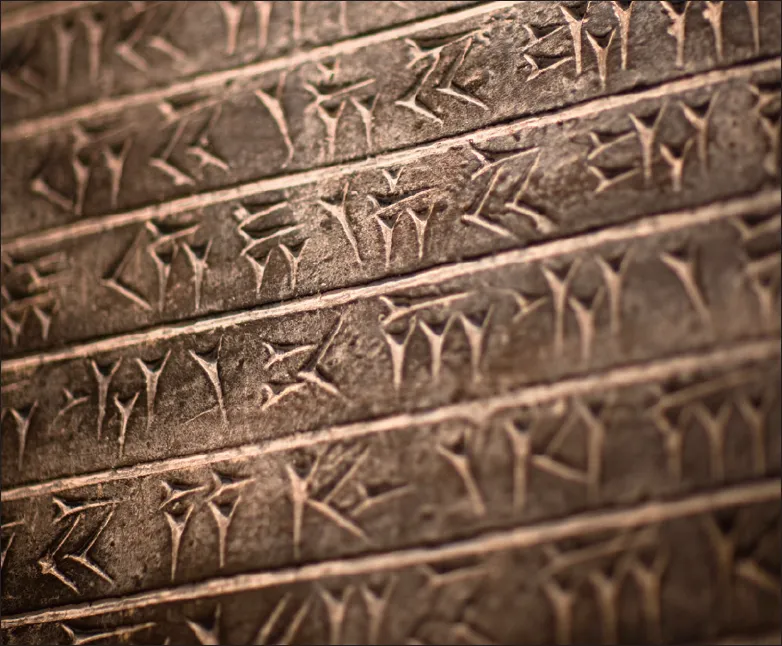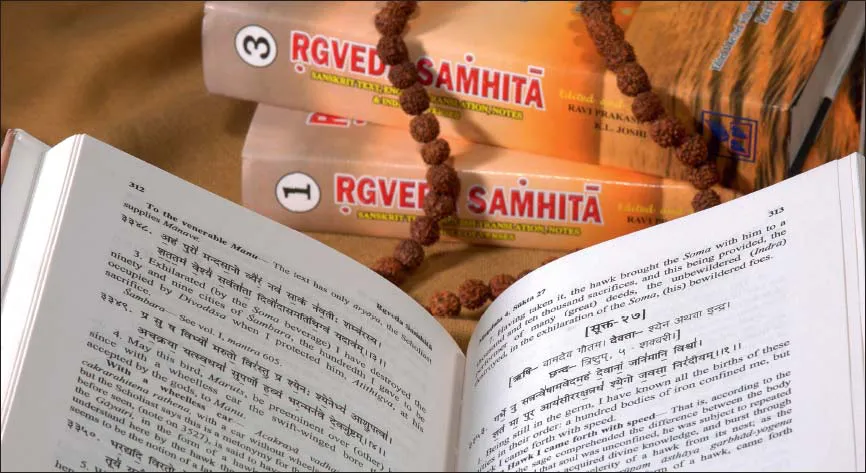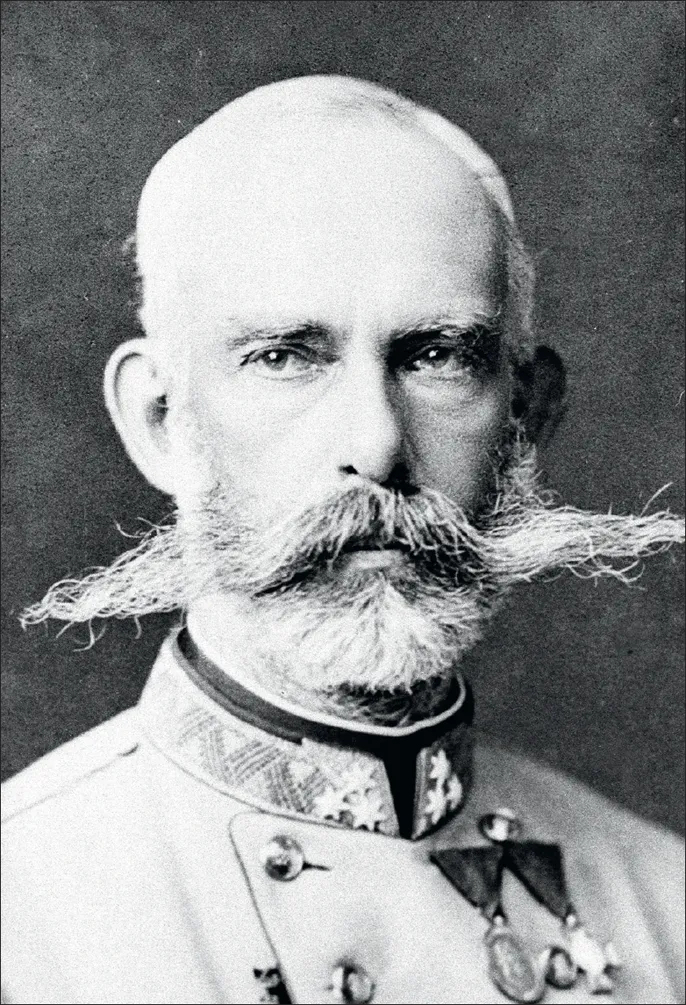
- English
- ePUB (mobile friendly)
- Available on iOS & Android
eBook - ePub
About this book
From Afghanistan to Zimbabwe, priceless documentary heritage records the diversity of languages, peoples and knowledge that has influenced humanity from the early days of human history to the present. This heritage documents important events, discoveries or inventions that have transformed the world.
Frequently asked questions
Yes, you can cancel anytime from the Subscription tab in your account settings on the Perlego website. Your subscription will stay active until the end of your current billing period. Learn how to cancel your subscription.
At the moment all of our mobile-responsive ePub books are available to download via the app. Most of our PDFs are also available to download and we're working on making the final remaining ones downloadable now. Learn more here.
Perlego offers two plans: Essential and Complete
- Essential is ideal for learners and professionals who enjoy exploring a wide range of subjects. Access the Essential Library with 800,000+ trusted titles and best-sellers across business, personal growth, and the humanities. Includes unlimited reading time and Standard Read Aloud voice.
- Complete: Perfect for advanced learners and researchers needing full, unrestricted access. Unlock 1.4M+ books across hundreds of subjects, including academic and specialized titles. The Complete Plan also includes advanced features like Premium Read Aloud and Research Assistant.
We are an online textbook subscription service, where you can get access to an entire online library for less than the price of a single book per month. With over 1 million books across 1000+ topics, we’ve got you covered! Learn more here.
Look out for the read-aloud symbol on your next book to see if you can listen to it. The read-aloud tool reads text aloud for you, highlighting the text as it is being read. You can pause it, speed it up and slow it down. Learn more here.
Yes! You can use the Perlego app on both iOS or Android devices to read anytime, anywhere — even offline. Perfect for commutes or when you’re on the go.
Please note we cannot support devices running on iOS 13 and Android 7 or earlier. Learn more about using the app.
Please note we cannot support devices running on iOS 13 and Android 7 or earlier. Learn more about using the app.
Yes, you can access Memory of the World by in PDF and/or ePUB format, as well as other popular books in History & World History. We have over one million books available in our catalogue for you to explore.
Information
MEMORY OF WORLD DOCUMENTS
ORDERED BY THE DATE THEY WERE RECORDED
The Hittite cuneiform tablets from Bogazköy
Inscribed 2001
What is it
Ancient Hittite texts preserved in cuneiform on 25,000 clay tablets.
Why was it inscribed
The Bogazköy archive of cuneiform tablets is the only source of information on the Hittites as well as on the social, political and commercial activities of the area. The archive sheds light not only on that area and period, but also on the history and the civilization of human kind as a whole.
Where is it
Archaeological Museums of Istanbul and Anatolian Civilizations Museum of Ankara, Turkey
Anatolia forms a bridge between Europe and Asia, and the area has been the cradle of many civilizations. The Hittites ruled here for nearly 600 years in the 2nd millennium BC, after moving from the Caucasus. They established a powerful state within a bend of the Kızılırmak river (the ancient Halys) with its capital at Bogazköy. The civilization of the Hittites was advanced in its military achievements, political organization, legislation and the administration of justice. Their military, political, social and commercial relations with neighbouring countries were all recorded and kept in archives meticulously.

Ancient Hittite cuneiform script
The state had a federal structure, and the central government was headed by the king who was also the commander of the army, the supreme judicial authority and the chief priest, though he was never actually deified. In fact, the Hittite king, for the first time in the history of the ancient east, possessed no divine attributes.
Excavations from 1906 to 1970 at Bogazköy (ancient Hattusas) uncovered thousands of cuneiform clay tablets in the Great Palace and in the Great Temple. The Bogazköy archive consists of nearly 25,000 cuneiform clay tablets and is the only extant material about the civilization of the Hittites. The tablets are mostly on political, military, social, commercial, religious and artistic topics relating to the Hittites and the neighbouring nations. The archive also includes sets of tablets on law codes, national and international treaties and correspondence.
The archive includes tablets of the Treaty of Quadesh signed between Hittites and Egypt. This well-known treaty of ‘eternal peace’ guaranteed harmony and security throughout the area for a considerable length of time. Now a symbol of the movement for peace, the Treaty of Quadesh adorns the walls of the United Nations Building in New York.
The archive includes tablets of many literary works, chiefly of an epic and mythological character; some of the most important of these tell the story of the exploits and quarrels of the gods. The tablets show the existence of eight different languages, illustrating the polyglot nature of the Hittite Empire.
The correspondence and other documents in the archive have a universal importance since they contain important information not only on the Hittite Empire, but also on the political and civil life of other neighbouring states and cities. Most of our knowledge relating to that period of history in Asia Minor and partially in the Arab region comes from the cuneiform tablets found at Bogazköy.

Sphinx Gate of Hattusas, Turkey
Rigveda
Inscribed 2007
What is it
Thirty manuscripts of the Rigveda, the oldest of the four Vedas which are the Hindu sacred texts of scripture. The Rigveda contains a collection of Sanskrit hymns and prayers and is believed to date to between 1700 BC and 1100 BC.
Why was it inscribed
The Vedas are among the first literary documents in human history but their significance goes beyond their scriptural importance. The Rigveda is considered the source of the culture that spread beyond the subcontinent to South, Southeast and Central Asia.
Where is it
Bhandarkar Oriental Research Institute, Pune, India
The Rigveda is a book of Sanskrit prayers, songs and hymns and is more than 3000 years old. The songs’ composers represent the origins of different families which are considered as the ancestors of the Hindus.
The hymns of the Rigveda vary in nature: most are written in praise and petition to different gods, while others are pieces of poetry. Some are connected with sacrificial rituals, and others accompany specific ceremonies, including marriage and funeral rites. Hymns of creation also feature together with beautiful descriptions of nature and considerations of various aspects of human behaviour.
The language in the Rigveda suggests that it is not a single, unitary work but instead is comprised of earlier and later elements. In fact, the manuscripts are believed to be the composition of several generations of poet-priests over a period of centuries. The songs and prayers also belong to different geographical regions, mostly on the Indian subcontinent, as illustrated by the variety of natural phenomena they mention.

The Vedic culture spread across Central and South Asia and was a significant contributor to the growth and development of Asian civilization. Some scholars also claim the culture extended as far as Europe in prehistoric times. So as well as its place as a sacred text of the Hindus, the Rigveda is considered an important text in studies of comparative religion and mythology, ritual, anthropology, prehistory and poetry.
The Institute holds thirty manuscripts of Rigveda from across India. Of these, twenty-nine are written on paper and one, from Kashmir, is on birch bark. Several of the manuscripts contain the complete intact text of the Rigveda, which is rare. Nevertheless, all are important in the cultural and social heritage of the world. Thirteen manuscripts contain one of the oldest available commentaries on the text, while another five have the Padapatha, the traditional word analysis of the text. These aids have helped greatly in interpreting and understanding the Rigveda.

A modern-day printing of the Rigveda
Papyrus Erzherzog Rainer
Inscribed 2001
What is it
A collection of around 180,000 written objects: papyri, parchment and paper; wooden tablets; ostraka, or pieces of inscribed pottery; cloths; and leather scrolls. The items date from the 15th century BC up to the 16th century AD.
Why was it inscribed
This collection of writing materials and languages is one of the most extensive in the world. Many of the important languages of the ancient world are represented in written form, including Egyptian, from hieroglyphics to Coptic; Greek; Latin; Hebrew and Aramaic; and Arabic. The papyri material covers a wide range of subject matter, from school and legal texts to writings on medicine, war and magic. Together, they allow insights into societies and cultures which have long since disappeared.
Where is it
Austrian National Library, Vienna, Austria
The collection was begun by Austrian historian and Orientalist Professor Josef von Karabacek, who was among the first to realise the importance of the papyri found at the Fayum oasis in Egypt in the late 1870s and early ’80s. Together with his collaborator Theodor Graf, Professor von Karabacek imported thousands of the finds into Austria. Archduke (or Erzherzog) Rainer, a former prime minister and a member of the Habsburg royal family, bought the collection in 1883.
Material continued to come from Egypt and the collection grew to almost its present size within a few years. In 1899 Professor von Karabacek became head of the Imperial Court Library and that same year the archduke gave his collection as a birthday gift to the Emperor Franz Josef I, requesting that it be placed in the Court Library.
The material in the papyri covers every aspect of life: literature, school texts, magic, religion, the afterlife, legal affairs, financial transactions, military matters, medicine, books and writing. Together, they offer a direct insight into the world as it was known at the time. For example, many of the cities, villages, churches and temples of ancient Egypt are known through these papyri. Byzantine tax receipts form a large part of the records, allowing the reconstruction of aspects of the social and economic history of the Byzantine Empire. Roman military papers reveal aspects of governance in Egypt and beyond. Family archives from various periods also feature in the collection.

Erzherzog Rainer, who acquired the collection in 1883.

The Fayum oasis in Egypt, where the papyri were first found in the 1870s.
Among the most impo...
Table of contents
- Cover
- Title Page
- Contents
- Foreword
- The emotional power of documents
- World map
- Memory of the World Register
- MEMORY OF WORLD DOCUMENTS
- Index
- Contact information
- Photo credits
- Acknowledgements
- Copyright
- About the Publisher